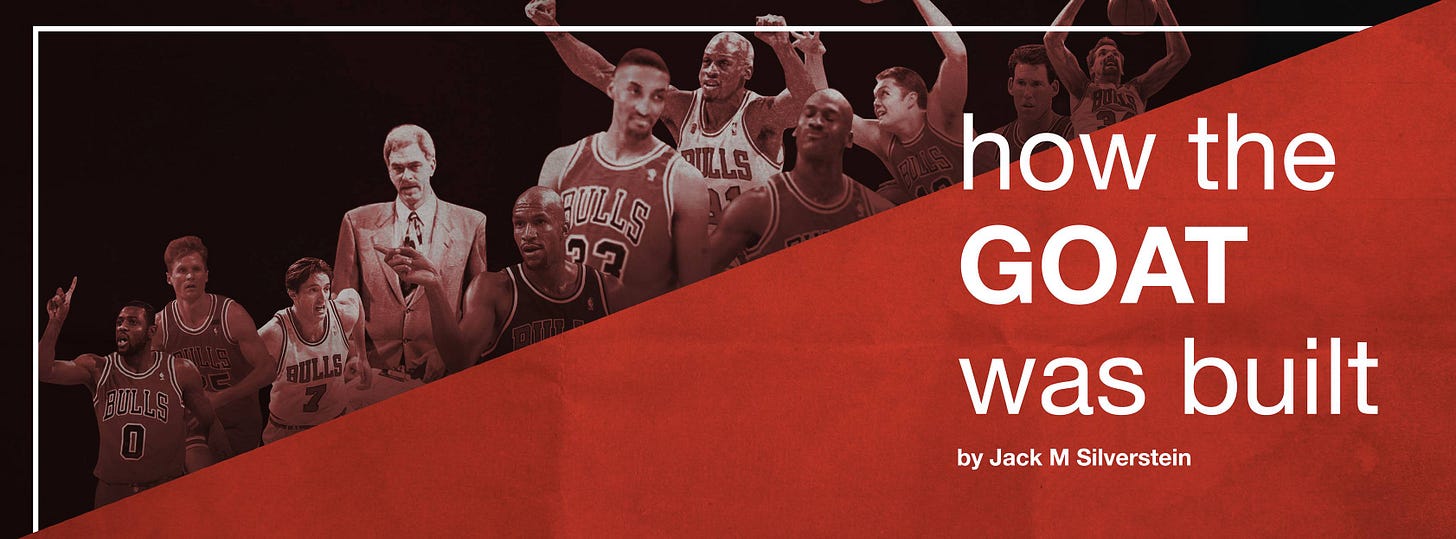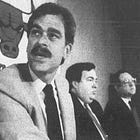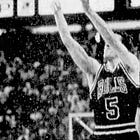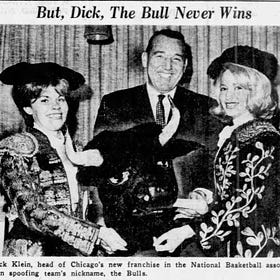The 1996 Chicago Bulls: forever the GOAT
Inside the enduring impact of the NBA's greatest season.
In the spring of 2016, the Golden State Warriors made Ron Harper a prophet.
Led by a transcendent Stephen Curry1, those Warriors were the rarest of rare teams: not just a great club, not just a juggernaut, but an instant icon. Their only competition was the 20-year-old ghost they were chasing.
That would be the ‘96 Bulls. During the 2016 playoffs, when the Warriors looked like a sure bet to become back-to-back champs, I published a chapter excerpt from my forthcoming ebook on those record-setting ‘96 Bulls. Titled “Dub-Bulls: How the 1996 Bulls led the small-ball revolution by going big,” the excerpt looked at how the ‘96 Bulls became the blueprint for the 2016 Warriors and for the 2010s NBA at large and its move toward “position-less basketball.”
Just as the 90s Bulls were the successor to the early 70s Knicks, the late-2010s Warriors were the successor of the 90s Bulls. The similarities were obvious: Jerry Reinsdorf and Jerry Krause had set out to build a team like Red Holzman’s Knicks and got one of Red Holzman’s role players to coach them — Phil Jackson.
The ‘90s Bulls used Tex Winter’s triangle offense and Johnny Bach’s doberman defense to match Holzman’s dual threats of ball movement and disruption. The ‘96 Bulls took the triangle to a new level with more shooting specialists and increased positional flexibility. Two decades later, role player Steve Kerr took those lessons into his new job as Warriors head coach.
“That was the first team I was ever part of or that I ever saw that would just switch 1 through 4,” Kerr said at the start of the 2015-16 season. “And we could even switch 1 through 5 when we had [Toni] Kukoc out there. So in some ways, that team was like a precursor to the Warriors.”
On the final night of the 2016 season, I sat in a bar and watched the 90s Bulls became, I thought, relics of the past. On one TV, Kobe Bryant was playing his final game, breaking Michael Jordan’s record for the most points in a game after age 37, ultimately scoring 60.
On another TV, I watched with reluctant respect as the Warriors won their 73rd game. Surely they would become back-to-back champs and finish the greatest season of all-time. I had titled my soon-to-launch book “How The GOAT Was Built” and the title was going to be obsolete within a month.
They had forgotten to heed the lessons of Ron Harper.
“Before the playoffs, Scottie and I went to eat, and we were just throwing out ideas (for team t-shirts), 72-10 this, 72-10 that,” Harper told Alex Wong in his ‘96 Bulls oral history. “I said to Scottie, ‘I got one. 72-10 don’t mean a thing without the ring.’ He’s like, ‘That’s kinda hot.’”
Pippen had a t-shirt connection and Pip and Harp printed shirts with the slogan for the Bulls. As Golden State drove toward the record, the phrase was on a lot of minds in Chicago, including Pip’s:
We all know how this ended. The Warriors jumped out to a 3-1 lead in the Finals before LeBron James and Kyrie Irving steered the Cavs to the historic championship comeback, giving the city of Cleveland its first major championship since the 1964 Browns. The Warriors did indeed break our record at 73-9, but without the championship they landed on a list with the likes of the 2001 Mariners and 2007 Patriots, clubs that set regular season wins records yet came up short.
“A glimpse of the future…” — the three areas of influence of the 1996 Bulls on the modern game
Tonight, Steve Kerr comes to the United Center in both of his roles: 1996 Bull and head coach of the Warriors. The Bulls have announced their Ring of Honor, a collection of all-time great players, coaches and executives — and one team: 1996. Before even talking about the record, the influence of that team is massive, and breaks down into three areas.
The first most obvious one is the style of play. Here’s how I described them in 2016:
Twenty years later, my number one vision of the Chicago Bulls in the spring of 1996 is 20 limbs and an approximate 35-foot combined wingspan fanned out like a flying octagon — five players between 6’6 and 6’11, four with point guard skills, four who could defend three positions, and a genius on the sideline joining his players in synced consciousness.
That position-free, malleable basketball was in Phil Jackson’s head starting in the fall of 1993, that brief window when we had finally signed Toni Kukoc and Michael hadn’t yet retired. Phil envisioned a lineup that he called “totally interchangeable at every position” with Michael, Scottie, Horace, Toni and Scott Williams. Of course, a week after Phil gave that quote to Sam Smith, Michael retired and everything changed.
When MJ came back a year and a half later, and we then traded for Dennis Rodman, Phil’s vision came true: Michael, Scottie, Harper, Toni and Rodman was the birth of the modern lineup. We could go a bit smaller with Kerr or a bit bigger with Luc Longley, who was one of the best passers we ever had in the triangle. We had Scottie, who took the point-forward mantle from Paul Pressey to a new level, and we had Toni, who combined the point-forward with the stretch-four.
The triangle offense is what unlocked this roster’s full potential. Today we’re used to seeing Nikola Jokić play at the top of the key in a triple-threat position. Bill Cartwright, Scott Williams, Dennis Rodman and Luc Longley weren’t going to do most of what Joker does, but what they would often do is end up with the ball in their hands at the elbow to trigger the offense. In the era of Hakeem, Shaq, Ewing and Robinson, a big man moving away from the basket or factoring in to the backdoor game or a high-post pick-and-roll was much less common.
The second area of influence was the three-point shooting, something that started with the 1991 team. As I noted two years ago, the Bulls had the greatest three-point shooting game in Finals history in Game 6, 1993, when we shot 71.4% from downtown.
The first three-peat had Craig Hodges, John Paxson and B.J. Armstrong as three-point specialists. Obviously MJ showed he could shoot the three, Scottie could too, Trent Tucker brought the heat from the arc and Bobby Hansen hit one of the most memorable 3s in Bulls history. The second three-peat brought that to a new level with Steve Kerr, the league’s greatest shooting specialist of his time. Toni could shoot from outside, MJ’s biggest play in the Flu Game was a 3, and Scottie, Harp, and Jud Buechler could all knock down the outside shot.
Having so many three-point specialists on a team, whether the first three-peat or the second, was not seen in the 1990s. The Bulls were at the forefront.
I mentioned Longley and Kukoc, and they bring us to the third area of influence: the international impact. The Bulls weren’t the first team to look for NBA talent outside of North America, but fellow Ring of Honor Jerry Krause was among the pioneers of overseas scouting, and the 1996 Bulls were among the first NBA champions with major contributions from multiple international players.
“I think one of the things you’ve got to consider when you talk about this Bulls team is that all year long, they’ve been giving fans of the basketball world a glimpse of the future, what the NBA is going to be like in the 21st century: it’s going to be an international league,” Julius Erving said during the 1996 playoffs. “They have two of the three best American players on their team, they have the best player ever playing from Croatia, they have the best player ever from the country of Australia. So we’re getting a sneak preview of what it’s going to be like in the 21st century.”
Last season, the MVP was from Cameroon (Joel Embiid), the Finals MVP was Serbian (Jokic) and #1 pick was French (Victor Wembanyama). The ‘96 Bulls are part of that legacy.
That’s probably not why they’re in the inaugural class of the Bulls Ring of Honor. The reason is much more simple. It boils down to one of my favorite reminders for hoops fans:
Greatest regular season ever: 2016 Warriors.
Greatest postseason ever: 2001 Lakers.
Greatest season ever: 1996 Bulls.
73-9 don’t mean a thing.
-
-
-
The least known member of the inaugural Chicago Bulls Ring of Honor class is the one man who made it all possible: team founder and original general manager Dick Klein. Learn about him here:
The Forgotten Bull: Dick Klein, Founder
“Pro basketball never had a true chance in this city. We’re going to promote the pants off it.” — Bulls founder Dick Klein in January 1966, upon launching the third and final NBA franchise in Chicago “Dick did the greatest selling job in the world to get the Bulls’ franchise started. He was so eager to prove his basketball genius to the world that he forg…
How crazy was Steph’s 2016 season? He set the NBA’s new season three-pointer record, making 402, an unheard of 41% increase over his own previous NBA record. For context, Barry Bonds over three seasons shattered Babe Ruth’s 1923 record for walks in a season, finishing with 232 walks in 2004. That was just 27% over Ruth. In 2013 Peyton Manning set the NFL single-season passing touchdown record with 55, a mere 14.6% increase over the long-time record of 48 set by Dan Marino in 1984. Perhaps no one in sports has crazier records than Wayne Gretzky, and his still-record 92 goals in 1982 is only 21% ahead of the prior record, Phil Esposito’s 76 goals in 1971. In 2016, Klay Thompson hit 276 3s, then good for three all-time. Steph and Klay kicked off a three-point revolution; today, 11 seasons are better than Klay’s 2016, but Steph’s 2016 remains #1 all-time.








